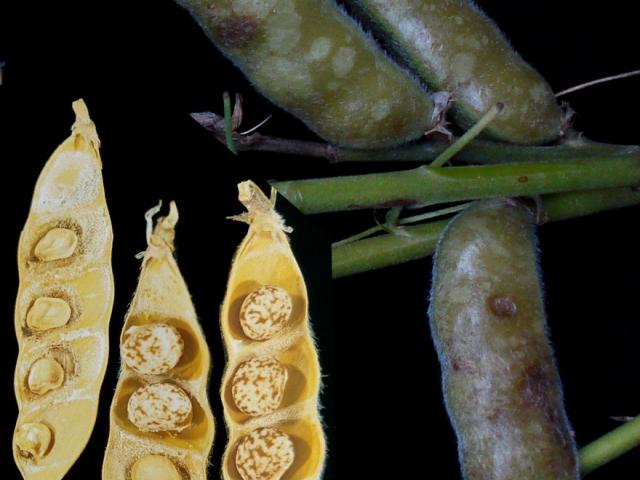Diagnosing frost in canola and pulses
A new guide has been published to assist growers to identify frost damage and consider crop management decisions. Download from here or the link in the right menu
To diagnose frost damage in pulse and canola crops, inspect between bud formation and during pod growth if night air temperature (recorded 1.2m above ground) falls below 2°C and there was a frost. Check low-lying, light-coloured soil types and known frost-prone areas first. Then check other areas. Symptoms may not be obvious for five to seven days after the frost.
Identifying frost damage
To identify frost damage, peel open flowers and pods on plants to clearly see affected parts. A magnifying glass and fine tweezers or a needle can be useful. Pulse and canola crops are most susceptible to frost damage around early flowering to late pod growth and seed fill.
- Buds, flowers, pods and seeds can all be affected by frost. In some circumstances all of these parts may be affected on a single plant, as the stages coincide with a damaging frost.
- Time of flowering affects susceptibility and the ability to compensate after the frost has occurred.
- For example, chickpeas often lose early flowers to frost but can continue flowering as long as water is available, thus compensating for the loss of early flowers.
- Canola flowers for a 30–40 day period, so compensatory growth can sometimes occur. A series of consecutive frosts can result in a forced delay of pod set, leading to poor seed fill, especially if a dry finish occurs.
- Monitor pod development and seed fill by tagging some reference plants and checking them a few days later for development or senescence (dying).
Lupins
Lupins have a very susceptible to frost and are generally unable to compensate after flowering.
- In the vegetative phase, leaves are scorched and withered and stems may be scorched (sometimes with brown discolouration).
- Flowers and developing seeds in pods are shrivelled or killed completely.
- It is often difficult to detect external pod damage.
For more information refer to Diagnosing frost in narrow-leafed lupins.
Faba beans
Faba beans have a medium susceptibility to frost due to thick pod walls, which provide insulation to the developing seeds.
- Growing points are sometimes distorted (bent) during early vegetative and flowering stages. This weakens the cells of the stem, allowing disease such as chocolate spot to invade easily.
- Flowers are killed by frost, leaving the flower stalk.
- White/green mottling and blistering of pods.
- Developing seeds in the pod are shrivelled or absent.
- Affected pods feel spongy and the seeds inside turn dark black.
Field peas
Field peas are very susceptible to frost due to thin pod walls and exposure of pods to the atmosphere.
- Flowers are killed by frost.
- Developing seeds in the pod are shrivelled or absent.
- White/green mottling and blistering of pods.
- Affected pods feel spongy and the seeds inside turn dark black.
For more information refer to Diagnosing frost in field peas.
Chickpeas
Chickpeas are very susceptible to frost due to the exposed nature of the flowers.
- Leaf margins are bleached.
- Flowers are killed.
- Growing points are sometimes distorted (bent) during early vegetative and flowering stages.
- Pods may develop, but seeds abort.
- Even after a frost, chickpeas will continue to flower and set pods well into spring.
Lentils
Lentils are susceptible to frost injury at flowering due to the exposed nature of the flowers and the small size of pods.
- Flowers are sometimes killed.
- Pods may develop, but seeds abort.
- Whole pods can be killed.
Canola
Canola is most susceptible to frost damage from flowering to the clear watery stage (approximately 60% moisture).
- Yellow green discolouration of pods.
- Scarring of external pod surfaces.
- Abortion of flowers.
- Shrivelling of pods.
- Pods eventually drop off.
- Shrivelling and absence of seeds.
- Canola flowers for a 30–40 day period, allowing pod set to continue after a frost. Open flowers are most susceptible to frost damage, pods and unopened buds usually escape. If seed moisture content is less than 40% when frost occurs, oil quality will not be affected.
For more information refer to Diagnosing frost damage in canola.



